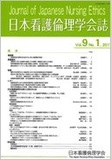Japanese
English
- 販売していません
- Abstract 文献概要
- 参考文献 Reference
- サイト内被引用 Cited by
看護師は多くの場合、倫理は日常業務に直接活用できないと考えており、抽象的・学問的なものと捉えている。また、倫理の言葉や専門用語は、自分たちからは遠いものと認識し、実践で体験するごく普通の問題や、自分たちの判断や行いが正しいだろうかという悩みを言い表す言葉ではないと思っていることも多い。さらに、たとえ倫理について考える場合でも、看護における倫理的な問題や倫理的責任はわれわれの文化に特有なものであり、他国の看護師が抱えるものとは別の類のものであると考えている。本講演では、看護実践の倫理に関わるこれらの問題をまず取り上げる。すなわち、倫理は、(1)実用的ではなく抽象的なものと捉えられている、(2)現実の事柄を言い表す言葉ではなく遠くにあるものと捉えられている、および、(3)普遍的ではなく文化固有のものであると認識されている、の三つである。しかし、これらの三つは、次の四つ目の問題の単なる背景であるとも考えられる。その四つ目の問題とは、「生命倫理」全般、および特に「看護倫理」において、概してドラマチックで大きな倫理的ジレンマが取り上げられ、そのせいで、「倫理には正しい答えは存在しない」という考え方がささやかれている、ということである。本講演で私が便宜上「ネオン倫理」と名付けているこうした倫理が示唆する内容のせいで、解決が極めて困難で、分別ある人にとんでもないと思わせるような、話題性に富む倫理問題に関心が向けられている。このような派手な倫理に代わり、私は、まじめな看護師がいつも直面する「日々の倫理」に目を向ける。日々の倫理が扱うのは、障害をもつ患者の自己概念の再構築をどう手助けすればよいか、患者とその家族との間の緊張状態にどう関わることができるのか、あるいは、医師の指示が患者によくないと思われるとき、看護師はどう対処したらよいか、などである。最後に、倫理的な看護実践が試される世界共通の問題として、いわゆる看護師の「板ばさみ状態」を、問題の五つ目として取り上げる。これは、患者が求めること、患者の家族が望むこと、師長や同僚が考える「看護師としてなすべきこと」、また患者を診る医師が指示し期待することが相対立し、看護師はそれらの板ばさみになる、という問題である。そのような状態にある看護師は悲惨な立場に置かれていると思われがちだ。しかし実際には、こういった対立による板ばさみから絶対に逃れられないのは患者である。患者に今後どのようなことが起こるかを決める人々の間で意見が対立するという状態は、患者にとっては本当に恐ろしいことである。しかし幸いにも、患者には自分とともに板ばさみになってくれる看護師がいる。患者にとって、看護師はいつもそばにいて、擁護し、安楽を気遣い、ケアしてくれる人である。患者の病状の判断をし、処置をし、環境を整える、そういう日々の世話をしてくれる存在である。おそらく、患者を真にケアしようとするならば、「板ばさみ状態にある看護師」こそが最善の(またある意味では最も強力な)立ち位置にあるのである。
Nurses often see ethics as abstract and academic—not as something directly applicable to their daily work. Nurses frequently find the specialized terms and language of ethics distancing—not descriptive of the ordinary problems working nurses experience or the worries nurses everywhere actually have about whether they are making the right decisions and doing the right things. And, if nurses think about ethics at all, they sometimes think their ethical problems and responsibilities are culturally specific—not the same as ethical problems and responsibilities of nurses around the world. This lecture will first address these challenges to ethical nursing practice:(1)that ethics is abstract, not applicable;(2)that ethics is distant, not descriptive; and(3)that ethics is cultural, not universal. These challenges, however, are simply background to a fourth challenge, which is that bioethics in general, and Nursing Ethics in particular, typically focuses on big, dramatic ethical dilemmas and, by doing so, implies that there are no right answers in ethics. What I will call “Neon Ethics” directs attention to flashy ethical issues, often ones that are exceedingly difficult to resolve, about which reasonable people deeply disagree. I will draw attention instead to “Everyday Ethics,” the kind of ethical problems conscientious nurses face regularly. These might include how to help a patient reshape her self-concept in the face of disability, how to handle tensions between patients and family members, or how to handle medical orders that do not seem right for the patient. Finally, one of the most common challenges to ethical nursing practice, around the world, is the problem nurses describe as being caught in the middle of conflicts between what their patients need, what patients' family members want, what nurse managers and colleagues think nurses ought to do, and what patients' physicians order or expect. This fifth challenge of being the nurse in the middle sounds like a terrible place to be. Actually, the patient is the one most inescapably in the middle, and it is indeed a scary place to be when there is conflict among those who decide what will happen to the patient. Fortunately, the patient has a nurse in the middle with him or her—a nurse to be a steady presence, to advocate, to comfort, to care, and to do the hands-on work day-by-day of assessing and treating the patient's illness and shaping the patient's environment. Perhaps being “the nurse in the middle” is the best (and in some ways the most powerful) place to be when it comes to actually caring for patients.
Copyright © 2017, The Japan Nursing Ethics Associatin. All rights reserved.


